
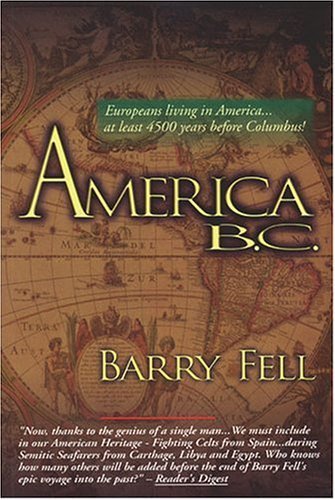
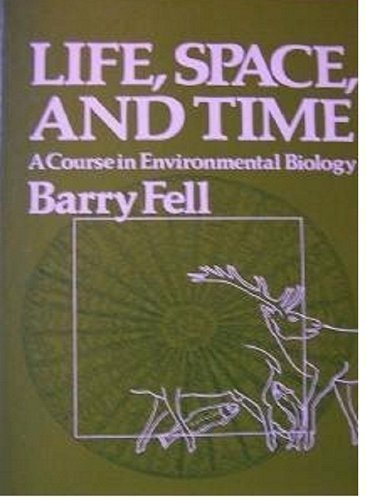

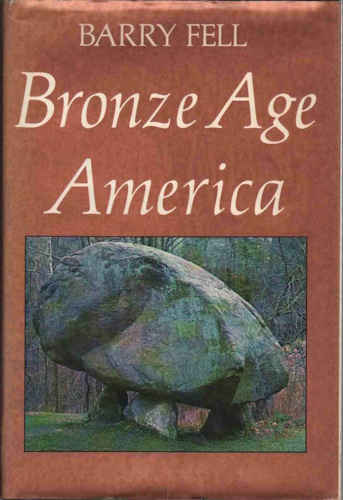



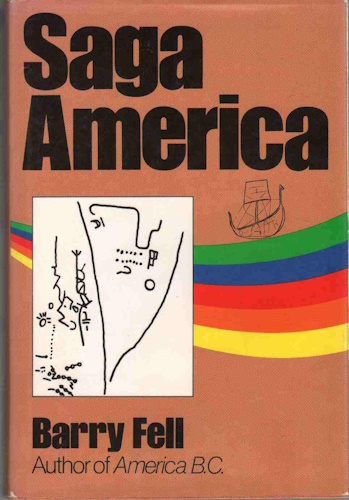

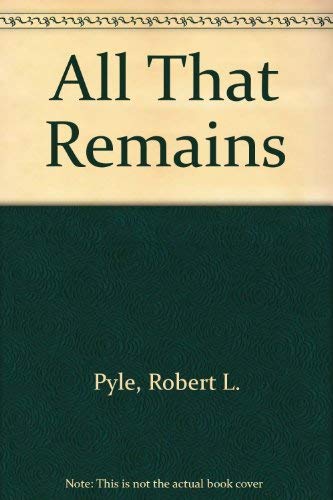

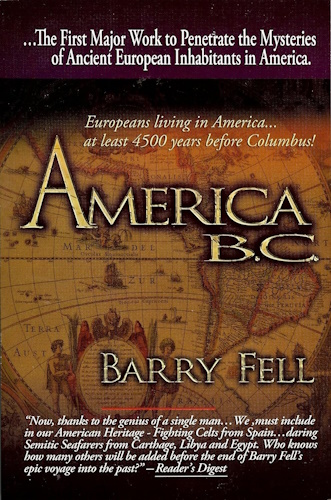

Prehistoric
American Colonization
by
Dr. Erich Fred Legner
from
Discoveries In Natural History & Exploration

An interview by Thomas Fleming1 with Dr. Barry Fell of Harvard University appeared in The Reader's Digest in 1977. In this article Fleming stated that although most Americans believe that their history began with Christopher Columbus, historians have lately discovered hard evidence that Leif Erickson and his fellow Norsemen were exploring Canada and the northern tier of the United States as early as 1000 A.D. However, before that date the history of the New World above the Rio Grande had been a virtual vacuum, inhibited by scattered Indian legends.
Now the genius of Dr. Barry Fell may have caused a significant advance in knowledge on what is known about early American colonization. In his published book, America B.C., 19763 New Zealand-born Barry Fell, a marine biologist at Harvard (19742), offered evidence that there were humans from Europe, not merely exploring but living in North America as early as 800 B.C. This was followed by additional books in 19824, 19835, 19856 and 19897 where the dates of such colonization were thought to have occurred as early as 1700 B.C. (See Bronze) The ancient settlers worked as miners, tanners and trappers, and shipped their products back to Europe. In temples in the rugged hills of New Hampshire and Vermont (Sce Photos-1 & Photos-2) and in river valleys in Iowa and Oklahoma they sang hymns and performed sacred rituals to honor their gods. When their kings or chiefs died, they buried them beneath huge mounds of earth in which they left steles—written testimony of their grief carved on stone.
Some of these steles were discovered in the 19th Century, and caused bewilderment over strange inscriptions carved on cliffs from the Maine coast to the Rio Grande and west to Nevada and California, or on stones that lay in obscure museums. However, the ancient writings could not be deciphered and were dismissed as forgeries or accidents of nature. Dr. Fell's expertise in this field known as epigraphy, which requires considerable knowledge of languages, is the tool which has enabled him to add a thousand years or more to America's past. Fell first became interested in ancient languages while a student at the University of Edinburgh. He learned Gaelic, and began to investigate ancient tombs and ruins in Scotland. Then, in a study of the marine biology of Polynesia, he found hundreds of unreadable inscriptions engraved on rocks and painted on cavern walls. More recent studies by Catherine Acholonu of Nigeria reveal the probable existence of even much earlier explorations to the New World.
Intrigued, Fell came to Harvard in 1964 and spent the next eight years exploring the Widener Library's unique collection of texts on obscure languages and writing systems. In the course of this effort he acquired a working knowledge of several ancient alphabets, including the hieroglyphics of the Egyptians = Punic); the script of the Carthaginians and Ogam, an almost forgotten script used by the pre-Christian Norse (often erroneously referred to as Celts—See Celts.)
Fell finally proved to his satisfaction that the Polynesian inscriptions were written in the native language, Maori. But its vocabulary was a mixture of Greek and Egyptian that was once spoken in Libya after Alexander the Great conquered Egypt. The alphabet was derived from Carthage.
The most remarkable of these Libyan texts was found in a huge cave in New Guinea. There a navigator named Maui left drawings of ancient but sophisticated astronomical and navigational instruments, as well as a depiction of a solar eclipse that enabled Fell, with the help of Harvard astronomers, to identify the year of the drawings as 232 B.C.
If these were Libyans visiting Polynesia at that time, Fell reasoned perhaps they sailed on to South America. He soon accumulated more evidence and began lecturing on it at Harvard. His talks attracted the attention of a group of investigators led by James P. Wittall II, an archeologist, who had noted the similarity between numerous crude stone buildings in New England which farmers often called root cellars, and similar ruins in Spain and Portugal. The European buildings had been identified as creations of Celts who ruled that part of Europe during the Bronze Age, the period of prehistory, which dates roughly from 3500 B.C.
Whittall asked Fell to take a look at the Bourne stone, which had been discovered near Bourne, Massachusetts around 1680. (Scan Photos) No one had ever been able to make any sense of the writing on it. Now, Dr. Fell was able to read it. The letters were a variation of the Punic alphabet, found in ancient Spain, for which Fell had coined the word "Iberic." It recorded the annexation of a large portion of present-day Massachusetts by Hanno, a prince of Carthage. Fell joined in a search for additional inscriptions at one of their favorite sites, Mystery Hill in North Salem, N.H.. (Scan Photos) This site consists of a series of slabstone buildings, variously attributed to Norsemen, wandering Irish monks, and a vanished tribe of Indians. Studying the inscribed triangular stones, which had previously been found at the site, Fell found a dedication to the Phoenician god Baal, written in Iberic. Then promptly other people began to See hitherto unnoticed inscriptions in the area. The owner of Mystery Hill, Bob Stone found another table in an adjacent drystone wall. When Fell brushed away the adhering soil, he was able to read a line of Ogam script that read "Dedicated to Bel."
Students of ancient mythology had long suspected that the Celtic sun god Bel and the Carthaginian-Phoenician god Ball were identical. Here, for the first time, there was evidence not only of this fact, but of a Celtic-Carthaginian partnership in exploration and settlement on a scale previously never even imagined.
In the following days Other Ogam inscriptions were located at another site in central Vermont (Scan Photos). Fell noted that it became clear that ancient Celts had build these stone chambers as religious shrines, and the Carthaginian mariners were visitors who were permitted to worship at them and make dedications in their own language to their own gods.
Then Whittall showed Fell a photograph of an inscription engraved on a cliff above Mount Hope Bay, in Bristol, Rhode Island, which was discovered and recorded in 1780. Because of vandalization, it was necessary to work from the photograph. Fell soon translated a single line, which was written in Punic: "Voyagers from Tarshish this stone proclaims."
Tarshish was a Biblical city on the southern coast of Spain, and its citizens were among the boldest sailors of antiquity, famous for the size of their ships. In 533 B.C., the Carthaginians and their trade taken over by these ambitious, daring sailors destroyed Tarshish. Here was evidence of how the partnership between Celts and the Carthaginians began.
On Monhegan Island, 12 miles off the coast of Maine, another inscription was brought to Dr. Fell's attention. It was written in Celtic Ogam and read, "Cargo platforms for ships from Phoenicia." [(Also scan Photos) ] From these and other inscriptions, as well as an intensive study of historical data on the seafaring ability of the men of Tarshish and Carthage, Fell concluded that there was a highly developed trade route between America and the Mediterranean for at least 400 years before the birth of Christ. The principal products from North America were probably copper, furs and hides. Fell noted that there was evidence of very early mining in the copper fields of Minnesota as well as of an extensive fur trade. The Carthaginians used to proclaim that they obtained their furs from Gaul. But when the Romans finally invaded Gaul, they found very little evidence of a fur trade. Thus, Gaul might have been a code word for America. A prevailing obstacle to verifying Bronze Age voyages from Europe to America is the absence of bronze tools among the American artifacts. (Please See Bronze Age Tools).
Data from America now began to multiply. Most important was Fell's translation of the Davenport stele, which some people compare to the translation of the Rosetta stone—the 19th-Century breakthrough that enabled a reading of hieroglyphics and to grasp the awesome sweep of Egyptian history. On this inscription, which was found in a burial mound near Davenport, Iowa in 1874, Dr. Fell was able to read three kinds of writing. At the top were Egyptian hieroglyphics. Below them was the Iberic form of Punic writing found in Spain. The third line was in Libyan script. This mean that there were Egyptians, Libyans and Celtic Iberians living together in a colony in Iowa in 900 B.C. It also means that we have to revise a lot of our ideas about American history in general and the culture of the Amerindians in particular.
Paying closer attention to native Amerindian languages, Barry Fell next reasoned that if these pre-Christian visitors actually colonized parts of America, they mush have left behind them a deep impression on the language and beliefs of the people they encountered. He soon found abundant evidence to support this conclusion.
One of Fell's colleagues brought him a book from Harvard's Widener Library that was written by a missionary priest and published din 1866. It contained a document titled "The Lord's Prayer in Micmac Hieroglyphics." Fell saw that at least half of these hieroglyphics were Egyptian. He was able to prove from the written testimony of other priests that the Micmacs were using this writing when the first missionaries arrived. In fact, all the Northern Algonquians, the family of tribes to which the Micmacs belonged, apparently used it, having acquired this language from Libyan mariners and preserved it for over 1000 years.
As Fell began to study the Algonquian language, he found hundreds of Egyptian words in the dialects of the Northeastern Algonquians. The verb na, to See, is the same in both languages. So is nauw, which means to be weak, and neechnw, which means child. The names of many New England rivers, one thought to be Amerindian, turn out to be derived from the once widespread language of West Africa and which later evolved into Basque (See: Nyland and Acholonu). Merrimack, for instance, means "deep fishing" in Algonquian. It is too close for coincidence to the Gaelic Mor-riomach, meaning "of great depth."
Barry Fell's suggestion that Egypt might have had intense contact with North America is strongly supported by the huge boats, which were discovered in 1950 adjacent to Khufu's great pyramid. They were buried between 2589 and 2566 B.C.. One has been restored and it shows considerable wear as if it had gone on long journeys. Its length is 43.63 meters, width 5.66 meters (See Egyptian Boat). This ship was perfectly capable of crossing the Atlantic. The other boats were left intact, awaiting additional funding to rebuild them as well. An excellent article about these boats may be found in the April/May 2004 issue of Ancient Egypt Magazine.
Edo Nyland's decipherment of the Horsecreek Petroglyph (See Horsecreek) in a West Virginia canyon using Basque showed it to be an eye witness account of a bison hunt, the animals being driven over a cliff. Nyland noted that the very large Ogam inscription in that canyon is written in a type of Ogam different from Irish, one that has never been used in Ireland. He suspected it to be Libyan Ogam (personal communication). The Libyans and Northern Egyptians at that time were blond and blue eyed.. Edo Nyland suspected that the Four Khalifs who conquered Egypt and Libya around 500 AD drove the blond people from their homeland. They made it clear that they would not tolerate any Nonbeliever religions. The blond people had excellent boats and they all sailed first to Ireland, from where the more adventurous ones went to North America, where they eventually joined the native life style. The 17th Century English settlers in the United States wrote home telling about native tribes with blond hair (Robert L. Pyle, All That Remains, pp 66) They were subsequently absorbed in the new population.
Evidence certainly abounds of much earlier contacts of humans in the Americas than has been presented here thus far. For example, there is a great diversity of human races depicted in Pre-columbian ceramic and stone artifacts scattered all over Mexico and Central America (See: "Ethnic Diversity"). Also the existence of human populations in eastern North America prior to the great die-back over 10,000 years ago is supported by the by the activity of mammoth hunters in southern Mexico and other parts of North America and the discovery of ancient small carvings on stones of camelids, the American lion and humans in northern American woodlands (See: "Early Humans"). There is conclusive evidence for the hunting by humans during the Pleistocene (See: Mammoths, Camelids, & Lions). Perhaps even hominids, such as Homo erectus, could have been present (See: "Kansas Site"). The lesson to be learned by all who probe into human pre-history is that There are no foolish questions, and no person becomes a fool until he or she has stopped asking them.
REFERENCES
1. Fleming, Thomas. 1977. Harvard scholar feels America discovered as early as 800 B.C. The Reader's Digest Assoc., Inc., Pleasantville, NY.
2. Fell, Barry. 1974. Life, Space and Time: A course in Environmental Biology
. Harper & Row, NY. 417 p.
3. Fell, Barry. 1976. America B.C.: Ancient Settlers in the New World
. Pocket Books, NY. 312 p.
4. Fell, Barry. 1982. Bronze Age America
. Little, Brown and Co., Boston, Toronto. 304 p.
5. Fell, Barry. 1983. Saga America
A Startling New Theory on the Old World Settlement of America before Columbus. Times Book, NY. 392 p.
6. Fell, Barry. 1985. Ancient Punctuation and the Los Lunas text
. The Epigraphic Society. p. 35-43.
7. Fell, Barry. 1989. America B.C.: Ancient Settlers in the New World, Revised Edition
. Pocket Books, NY. (revised ed.)
Mammoth images = By Dantheman9758 at the English language Wikipedia, CC BY-SA 3.0
American Lion image = By Dantheman9758 at the English language Wikipedia, CC BY-SA 3.0
North America camel = By Sergiodlarosa, CC BY-SA 3.0
![]()
![]()
Disclaimer:
Some material presented will contain links, quotes, ideologies, etc., the contents of which should be understood to first, in their whole, reflect the views or opinions of their editors, and second, are used in my personal research as "fair use" sources only, and not espousement one way or the other. Researching for 'truth' leads one all over the place...a piece here, a piece there. As a researcher, I hunt, gather and disassemble resources, trying to put all the pieces into a coherent and logical whole. I encourage you to do the same. And please remember, these pages are only my effort to collect all the pieces I can find and see if they properly fit into the 'reality aggregate'.
Personal Position:
I've come to realize that 'truth' boils down to what we 'believe' the facts we've gathered point to. We only 'know' what we've 'experienced' firsthand. Everything else - what we read, what we watch, what we hear - is what someone else's gathered facts point to and 'they' 'believe' is 'truth', so that 'truth' seems to change in direct proportion to newly gathered facts divided by applied plausibility. Though I believe there is 'truth', until someone representing the celestial realm visibly appears and presents the heavenly records of Facts And Lies In The Order They Happened, I can't know for sure exactly what "the whole truth' on any given subject is, and what applies to me applies to everyone. Until then I'll continue to ask, "what does The Urantia Book say on the subject?"
~Gail Bird Allen
![]()
![]()













-
Urantia Book, 44:0.11 - The Celestial Artisans
Never in your long ascendancy will you lose the power to recognize your associates of former existences. Always, as you ascend inward in the scale of life, will you retain the ability to recognize and fraternize with the fellow beings of your previous and lower levels of experience. Each new translation or resurrection will add one more group of spirit beings to your vision range without in the least depriving you of the ability to recognize your friends and fellows of former estates.
-
Princess Bride 1987 Wallace Shawn (Vizzini) and Mandy Patinkin (Inigo Montoya)
Vizzini: HE DIDN'T FALL? INCONCEIVABLE.
Inigo Montoya: You keep using that word. I do not think it means what you think it means. -
Urantia Book, 117:4.14 - The Finite God
And here is mystery: The more closely man approaches God through love, the greater the reality -- actuality -- of that man. The more man withdraws from God, the more nearly he approaches nonreality -- cessation of existence. When man consecrates his will to the doing of the Father's will, when man gives God all that he has, then does God make that man more than he is.
-
Urantia Book, 167:7.4 - The Talk About Angels
"And do you not remember that I said to you once before that, if you had your spiritual eyes anointed, you would then see the heavens opened and behold the angels of God ascending and descending? It is by the ministry of the angels that one world may be kept in touch with other worlds, for have I not repeatedly told you that I have other sheep not of this fold?"
-
Urantia Book, Foreword - 0:12.12 - The Trinities
But we know that there dwells within the human mind a fragment of God, and that there sojourns with the human soul the Spirit of Truth; and we further know that these spirit forces conspire to enable material man to grasp the reality of spiritual values and to comprehend the philosophy of universe meanings. But even more certainly we know that these spirits of the Divine Presence are able to assist man in the spiritual appropriation of all truth contributory to the enhancement of the ever-progressing reality of personal religious experience—God-consciousness.
-
Urantia Book, 1:4.3 - The Mystery Of God
When you are through down here, when your course has been run in temporary form on earth, when your trial trip in the flesh is finished, when the dust that composes the mortal tabernacle "returns to the earth whence it came"; then, it is revealed, the indwelling "Spirit shall return to God who gave it." There sojourns within each moral being of this planet a fragment of God, a part and parcel of divinity. It is not yet yours by right of possession, but it is designedly intended to be one with you if you survive the mortal existence.
-
Urantia Book, 1:4.1 - The Mystery Of God
And the greatest of all the unfathomable mysteries of God is the phenomenon of the divine indwelling of mortal minds. The manner in which the Universal Father sojourns with the creatures of time is the most profound of all universe mysteries; the divine presence in the mind of man is the mystery of mysteries.
-
Urantia Book, 1:4.6 - The Mystery Of God
To every spirit being and to every mortal creature in every sphere and on every world of the universe of universes, the Universal Father reveals all of his gracious and divine self that can be discerned or comprehended by such spirit beings and by such mortal creatures. God is no respecter of persons, either spiritual or material. The divine presence which any child of the universe enjoys at any given moment is limited only by the capacity of such a creature to receive and to discern the spirit actualities of the supermaterial world.
-
Urantia Book, 11:0.1 - The Eternal Isle Of Paradise
Paradise is the eternal center of the universe of universes and the abiding place of the Universal Father, the Eternal Son, the Infinite Spirit, and their divine co-ordinates and associates. This central Isle is the most gigantic organized body of cosmic reality in all the master universe. Paradise is a material sphere as well as a spiritual abode. All of the intelligent creation of the Universal Father is domiciled on material abodes; hence must the absolute controlling center also be material, literal. And again it should be reiterated that spirit things and spiritual beings are real.
-
Urantia Book, 50:6.4 - Planetary Culture
Culture presupposes quality of mind; culture cannot be enhanced unless mind is elevated. Superior intellect will seek a noble culture and find some way to attain such a goal. Inferior minds will spurn the highest culture even when presented to them ready-made.
-
Urantia Book, 54:1.6 - True And False Liberty
True liberty is the associate of genuine self-respect; false liberty is the consort of self-admiration. True liberty is the fruit of self-control; false liberty, the assumption of self-assertion. Self-control leads to altruistic service; self-admiration tends towards the exploitation of others for the selfish aggrandizement of such a mistaken individual as is willing to sacrifice righteous attainment for the sake of possessing unjust power over his fellow beings.
-
Urantia Book, 54:1.9 - True And False Liberty
How dare the self-willed creature encroach upon the rights of his fellows in the name of personal liberty when the Supreme Rulers of the universe stand back in merciful respect for these prerogatives of will and potentials of personality! No being, in the exercise of his supposed personal liberty, has a right to deprive any other being of those privileges of existence conferred by the Creators and duly respected by all their loyal associates, subordinates, and subjects.
-
Urantia Book, 54:1.8 - True And False Liberty
There is no error greater than that species of self-deception which leads intelligent beings to crave the exercise of power over other beings for the purpose of depriving these persons of their natural liberties. The golden rule of human fairness cries out against all such fraud, unfairness, selfishness, and unrighteousness.




